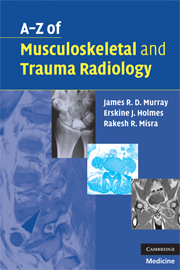Book contents
- Frontmatter
- Contents
- Acknowledgements
- Preface
- List of abbreviations
- Section I Musculoskeletal radiology
- Section II Trauma radiology
- ATLS – Advanced Trauma Life Support
- Acetabular fractures
- Aortic rupture
- Cervical spine injury
- Flail chest
- Haemothorax
- Open fractures
- Pelvic fracture
- Peri-physeal injury
- Pneumothorax
- Rib/sternal fracture
- Skull fracture
- Thoraco-lumbar spine fractures
- Acromioclavicular joint injury
- Carpal dislocation and instability
- Clavicular fractures
- Elbow injuries and distal humeral fractures
- Hand injuries – general principles
- Hand injuries – specific examples
- Thumb metacarpal fractures
- Humerus fracture – proximal fractures
- Humerus fracture – shaft fractures
- Humerus fracture – supracondylar fractures – paediatric
- Radius fracture – head of radius fractures
- Radius fracture – shaft fractures
- Galeazzi fracture dislocation
- Radius fracture – distal radial fractures
- Related wrist fractures
- Scaphoid fracture
- Scapular fracture
- Shoulder dislocation
- Ulna fracture – proximal and olecranon fractures
- Ulna fracture – shaft fractures
- Monteggia fracture dislocation
- Accessory ossicles of the foot
- Ankle fractures
- Bone bruising
- Calcaneal (Os calcis) fractures
- Femoral neck fracture
- Femoral shaft fracture
- Femoral supracondylar fracture
- Hip dislocation – traumatic
- Knee soft-tissue injury
- Metatarsal fractures – commonly fifth MT base
- Patella fracture
- Tibial-plateau fracture
- Tibial-shaft fractures
- Tibial-plafond (Pilon) fractures
- Talus fractures/dislocations
Tarsal fractures and toe phalangeal injury
from Section II - Trauma radiology
Published online by Cambridge University Press: 22 August 2009
- Frontmatter
- Contents
- Acknowledgements
- Preface
- List of abbreviations
- Section I Musculoskeletal radiology
- Section II Trauma radiology
- ATLS – Advanced Trauma Life Support
- Acetabular fractures
- Aortic rupture
- Cervical spine injury
- Flail chest
- Haemothorax
- Open fractures
- Pelvic fracture
- Peri-physeal injury
- Pneumothorax
- Rib/sternal fracture
- Skull fracture
- Thoraco-lumbar spine fractures
- Acromioclavicular joint injury
- Carpal dislocation and instability
- Clavicular fractures
- Elbow injuries and distal humeral fractures
- Hand injuries – general principles
- Hand injuries – specific examples
- Thumb metacarpal fractures
- Humerus fracture – proximal fractures
- Humerus fracture – shaft fractures
- Humerus fracture – supracondylar fractures – paediatric
- Radius fracture – head of radius fractures
- Radius fracture – shaft fractures
- Galeazzi fracture dislocation
- Radius fracture – distal radial fractures
- Related wrist fractures
- Scaphoid fracture
- Scapular fracture
- Shoulder dislocation
- Ulna fracture – proximal and olecranon fractures
- Ulna fracture – shaft fractures
- Monteggia fracture dislocation
- Accessory ossicles of the foot
- Ankle fractures
- Bone bruising
- Calcaneal (Os calcis) fractures
- Femoral neck fracture
- Femoral shaft fracture
- Femoral supracondylar fracture
- Hip dislocation – traumatic
- Knee soft-tissue injury
- Metatarsal fractures – commonly fifth MT base
- Patella fracture
- Tibial-plateau fracture
- Tibial-shaft fractures
- Tibial-plafond (Pilon) fractures
- Talus fractures/dislocations
Summary
Characteristics
Diverse group of injuries – note metatarsal/Lisfranc section above.
Navicular fractures are divided into four types – dorsal lip (avulsion), tuberosity, body and stress fractures.
Cuboid injury is usually undisplaced fracture which responds well to hard-soled shoe orthoses. Beware of the ‘Nutcracker fracture’, a high energy abduction injury, crushing the cuboid, shortening the lateral column and potentially extruding the cuboid. This requires ORIF usually.
Cuneiform injury is rarely isolated and responds to POP immobilisation unless significantly displaced when ORIF is the normal treatment.
Most phalangeal fractures occur in the proximal phalanx of the fifth toe following indirect trauma – stubbing of the toe.
Metatarsophalangeal and interphalangeal dislocations should be reduced a soon as possible but rarely require surgery unless open injuries.
Clinical features
Pain, swelling and sometimes deformity.
Careful identification of the most tender area will be particularly beneficial when assessing the X-ray.
Foot compartment syndrome must be suspected in a painful swollen foot and tested for by passively stretching the muscles of the relevant compartment.
Radiological features
AP and lateral X-rays centred on the area of tenderness are essential.
Look for significant angulation, intra-articular steps and joint subluxation.
If there is doubt regarding fracture extent or joint congruity then CT scanning is extremely helpful.
Management
ABCs, assess soft tissues, neurovascular status, reduce fractures/dislocations obviously threatening the skin and immobilise with backslab.
Admit, elevate and assess for compartment syndrome in the severely injured foot even without fractures.
General trauma principles apply such that joint congruity must be restored, either following joint dislocation or in intra-articular fractures.
Navicular body fractures usually require ORIF.
Nutcracker cuboid fractures are normally treated with ORIF and bone graft.
[…]
- Type
- Chapter
- Information
- A-Z of Musculoskeletal and Trauma Radiology , pp. 341 - 344Publisher: Cambridge University PressPrint publication year: 2008



